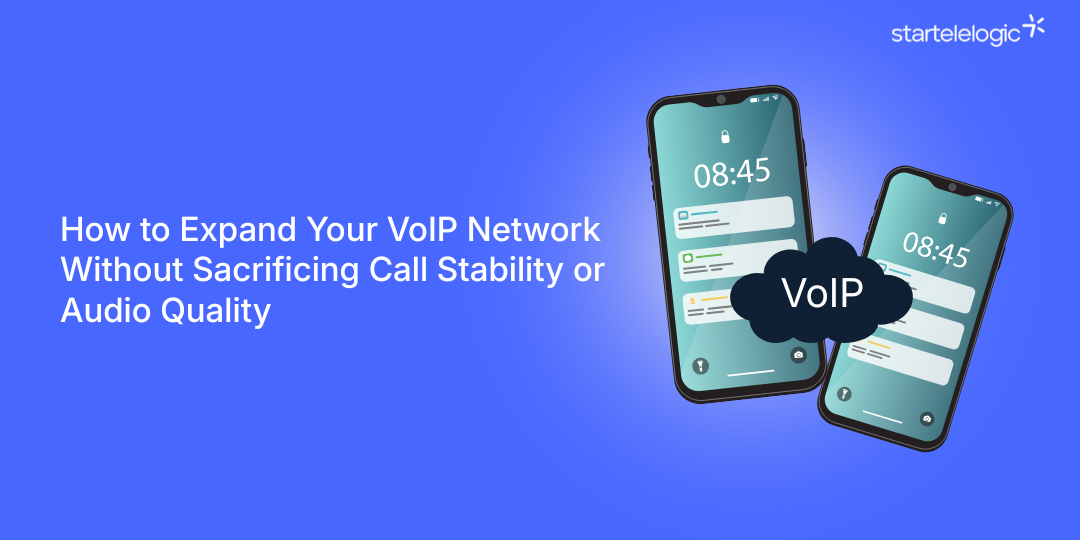Expanding a Voice over Internet Protocol (VoIP) network has become a quantitatively significant priority for modern enterprises, especially as the global VoIP services market is forecast to surpass $340 billion by 2032, reflecting a compound annual growth rate (CAGR) driven by measurable demand increases across all major sectors. Financial data indicates that organizations adopting VoIP realize an average 40–50% reduction in monthly telephony costs, underscoring the economic incentive behind large-scale deployments. However, scaling introduces measurable risks: network performance studies show that when packet loss exceeds 1%, or latency surpasses 150 ms, the Mean Opinion Score (MOS) typically falls below the industry-accepted threshold of 4.0, correlating strongly with spikes in call-quality complaints and productivity impacts. As enterprises grow their VoIP footprint, maintaining statistical control over these performance indicators becomes essential. This article presents evidence-based VoIP scaling stability best practices designed to ensure that VoIP scalability does not compromise the high-fidelity audio quality users depend on.
1. Robust Network Infrastructure: The Foundation of Stability
The bedrock of any scalable VoIP network is a robust and well-designed underlying infrastructure.
- Prioritize Bandwidth: VoIP traffic, while efficient, still requires dedicated bandwidth. As you add more users and concurrent calls, ensure your internet connection can comfortably handle the increased load. Conduct regular bandwidth audits and upgrade as needed.
- Quality of Service (QoS) Implementation: QoS is non-negotiable for VoIP. It prioritizes voice packets over less time-sensitive data, preventing jitter, latency, and packet loss. Configure QoS across all network devices, including routers, switches, and firewalls, with appropriate settings for your VoIP solution.
- Redundant Connections: Single points of failure are a scalability killer. Implement redundant internet connections and network devices to ensure continuous service even if one component fails. Consider failover mechanisms that automatically switch to a backup connection.
- Segment Your Network (VLANs): Utilizing Virtual Local Area Networks (VLANs) to separate voice traffic from data traffic significantly improves performance and security. This isolation prevents data-heavy applications from impacting call quality and makes troubleshooting easier.
- Modern Network Hardware: Outdated routers, switches, and firewalls can become bottlenecks as your network grows. Invest in modern, enterprise-grade hardware capable of handling high traffic volumes and advanced QoS configurations.
2. Strategic IP Addressing and SIP Trunking
Efficient IP address management and smart SIP trunking are crucial for scalable VoIP.
- Ample IP Address Space: Ensure your IP addressing scheme can accommodate future growth. If using Private IP addresses, be mindful of NAT traversal issues.
- Scalable SIP Trunking: Choose a SIP trunk provider that offers flexible and scalable plans. They should be able to instantly provision additional channels as your call volume increases. Look for providers with geographically redundant data centers for enhanced reliability.
- Local Breakout: For larger organizations with multiple locations, consider implementing local breakout for SIP trunks. This allows each branch office to have its own direct connection to the PSTN (Public Switched Telephone Network), reducing reliance on a central location and improving call quality by minimizing latency.
3. Monitoring and Management: Staying Ahead of Issues
Proactive monitoring and effective management are key to maintaining stability as you scale.
- Comprehensive Monitoring Tools: Deploy VoIP-specific monitoring tools that track key metrics like jitter, latency, packet loss, and Mean Opinion Score (MOS). These tools provide real-time insights into network performance and help identify potential issues before they impact users.
- Proactive Alerting: Configure alerts to notify your IT team of any deviations from normal performance thresholds. This allows for immediate action to prevent minor issues from escalating into major outages.
- Centralized Management Platform: As your network expands, managing individual devices becomes cumbersome. A centralized management platform for your VoIP system and network infrastructure streamlines configuration, updates, and troubleshooting.
- Regular Performance Audits: Conduct periodic performance audits to assess your network’s capacity and identify any potential bottlenecks. This data can inform future expansion plans and infrastructure upgrades.
4. Security Considerations: Protecting Your Growing Network
A larger network presents a larger attack surface. Robust security is essential for stable and reliable VoIP.
- Firewall Configuration: Properly configure firewalls to allow necessary VoIP traffic while blocking malicious attempts. Implement Session Border Controllers (SBCs) for enhanced security and NAT traversal.
- Strong Authentication: Enforce strong passwords and multi-factor authentication (MFA) for all VoIP accounts and administrative access.
- Regular Software Updates: Keep all VoIP software, firmware, and operating systems up to date to patch known vulnerabilities.
- DDoS Protection: As VoIP becomes mission-critical, protecting against Distributed Denial of Service (DDoS) attacks is vital. Utilize DDoS mitigation services provided by your ISP or a specialized vendor.
- Encryption: Implement SRTP (Secure Real-time Transport Protocol) for voice encryption to protect call privacy, especially in sensitive environments.
5. Vendor Relationships and Support
The right partnerships can significantly impact your scaling success.
- Reliable VoIP Provider: Choose a VoIP service provider with a proven track record of scalability, reliability, and excellent customer support. They should be able to grow with you and offer expert guidance.
- SLA Agreements: Ensure your Service Level Agreements (SLAs) with both your ISP and VoIP provider clearly define uptime, performance metrics, and support response times.
- Expert Consultation: Don’t hesitate to engage VoIP consultants or network specialists when planning major expansions. Their expertise can help you avoid common pitfalls and optimize your infrastructure.
Conclusion
Scaling a VoIP network without sacrificing call stability or audio quality requires a holistic approach. By investing in a robust infrastructure, implementing smart management practices, prioritizing security, and fostering strong vendor relationships, organizations can confidently expand their communication capabilities. Proactive planning, continuous monitoring, and a commitment to best practices will ensure your VoIP network remains a reliable and high-performing asset, even as it grows to meet the demands of your evolving business.
Frequently Asked Questions (FAQs) for VoIP Network Expansion
1. What is the single most critical factor in ensuring good audio quality during VoIP network expansion?
The single most critical factor is the implementation and configuration of Quality of Service (QoS) across your entire network. QoS prioritizes time-sensitive voice packets over general data traffic, effectively minimizing latency, jitter, and packet loss. Without proper QoS, a scalable network might handle the volume of calls, but the call quality will degrade significantly under heavy load.
2. How can I test my network’s capacity and determine if it’s ready for more VoIP users?
You can test your network’s readiness through VoIP stress testing and network performance monitoring. Specifically, you should:
- Measure key performance indicators (KPIs): Monitor your network for latency (ideally $<150 \text{ ms}$ one-way), jitter (ideally $<30 \text{ ms}$), and packet loss (ideally $<1\%$).
- Run simulation tests: Use specialized tools to simulate the expected number of concurrent calls and monitor how your network infrastructure (switches, routers, bandwidth) handles the increased load.
- Calculate required bandwidth: Use the G.729 codec (common standard) which requires approximately $30-40 \text{ kbps}$ per call (bi-directional), and multiply this by your peak concurrent call estimate.
3. Is there a difference between scaling for stability versus scaling for security?
Yes, there is a distinct difference, although they are interconnected:
- Scaling for Stability primarily involves network engineering (e.g., adequate bandwidth, QoS, network redundancy, and load balancing) to ensure calls connect reliably and maintain quality.
- Scaling for Security primarily involves implementing protective measures (e.g., Session Border Controllers (SBCs), strong authentication, firewall rules, and encryption protocols like SRTP) to defend the growing network against threats like toll fraud, Denial of Service (DoS) attacks, and eavesdropping. A security breach will ultimately destroy stability, so both must be scaled simultaneously.
4. How does separating voice and data traffic help with scalability?
Separating voice traffic from data traffic, typically using Virtual Local Area Networks (VLANs), is essential for stability. This separation:
- Ensures QoS is effective: Voice traffic can be assigned its own priority and bandwidth rules without interference from data applications (like file transfers or video streaming).
- Simplifies troubleshooting: If call quality issues arise, the IT team can focus their investigation solely on the voice VLAN, isolating the problem quickly.
- Reduces network congestion: It prevents the voice packets from getting stuck behind large data packets, which is the root cause of jitter and latency.
5. What role do Session Border Controllers (SBCs) play in a growing VoIP network?
SBCs are crucial for scaled VoIP stability and security, acting as a “smart” firewall for voice. They provide three critical functions:
- Security: Protecting the core network from attacks and enforcing encryption.
- Interoperability: Resolving signaling and media incompatibilities between different network segments or carriers.
- Network Address Translation (NAT) Traversal: Allowing VoIP devices on private IP addresses to communicate successfully with the public internet, which is vital in large, distributed networks.
6. When scaling to multiple geographic locations, what is a key consideration for maintaining quality?
When expanding to multiple geographic locations, a key consideration is Minimizing Latency and Implementing Local Breakout.
- Latency: The greater the physical distance, the higher the latency will be. Strategically placing your PBX (Private Branch Exchange) or using a distributed cloud architecture closer to the end-users is essential.
- Local Breakout: Instead of routing all calls back to a central office before connecting to the public telephone network (PSTN), implement local SIP trunks at each branch office. This allows calls to and from that location to break out to the PSTN locally, dramatically reducing the travel distance and improving both latency and reliability.




